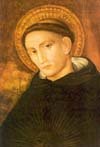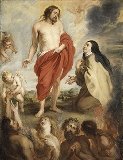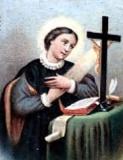2007 March - April Newsletter
ROME, ITALY

ROME (Reuters) - If you end up in Purgatory after you die, never fear. Just remember to send a message to those surviving you, care of a riverside church in Rome. The Church of the Sacred Heart houses one of the world's most unusual and smallest museums -- a collection of signs sent from beyond the grave by souls stranded in Purgatory.
Scorched fingerprints on prayer books, handprints burnt on wooden tables, and singed pillowcases and shirt sleeves seem to be the Purgatory equivalent of paper and pen.
"Most of our visitors are motivated by curiosity. But faith is the key to understanding the relics," says Roberto Zambolin, the church's tour guide.
Catholics believe spirits, stuck between heaven and hell until they have atoned for their sins, can hasten their entry to paradise if family and friends on earth pray for them. And some Purgatory residents obviously felt their loved ones needed a gentle reminder.
Branding an imprint of his left hand on to a light-brown wooden table was one 18th-century friar's way of reminding colleagues to say more masses and speed his soul to Heaven. On a single day in 1731, the deceased Friar Panzini not only marked the table, but burnt a handprint onto paper and twice clutched at the sleeves of a nun's tunic, leaving scorch marks. Panzini's spiritual smoke signals are a taste of what's on display in a bare room, dubbed the Little Purgatory Museum, off to the side of the church.
While most tourists to Rome flock to the Coliseum or the Vatican, the Sistine Chapel or the Trevi Fountain, some stray off the beaten track to the quiet and unassuming museum to ponder the mysterious relics, gathered from all over Western Europe.
The museum is said to get about 4,000 visitors a year -- young, old, Italians, foreigners, believers and non-believers.
Peering at four fiery fingerprints emblazoned on a prayer book, Austrian students debated the validity of the relics. "I believed in Purgatory before, but seeing these relics reinforces my faith, said a twenty-five year-old, but his 19-year-old friend was more hesitant. "I'm not sure what I think. They are certainly spooky but even if it's not true, it's a good story, said the 19 year old..
The museum, about 100 years old, was the brainchild of Victor Jouet, a French priest who traveled to Belgium, France, Germany and Italy, scooping up relics to display in his gothic church on the banks of the Tiber. Jouet died in the museum's only room in 1912, surrounded by his treasures, but the collection lives on despite a discussion in the late 1990s about whether to close it.
"We realized that most visitors were not Christians but those interested in the paranormal, or in some cases the devil, said the museum curator. "The Church didn't want to encourage something that wasn't to do with faith. But in the end the decision was made to keep it open. The collection does start discussions about Catholic ideas," he added.
And although most of the fiery signals date back to the 19th century or earlier, he doesn't think the lack of modern-day signs has any significance. "We don't get any new objects sent to us, but we don't need new signals to believe in Purgatory today."
FROM THE TEACHING OF THE CHURCH

The existence of Purgatory is defined as a dogma of the Church by both the Council of Florence and the Council of Trent. Thus it is obligatory for all Catholics who wish to remain in communion with the Church to accept and believe in the existence of Purgatory. The Council of Trent further defined that the souls detained in Purgatory are able to be assisted by the faithful on earth especially by the Holy Sacrifice of the Mass - see Council of Trent Session XXV.
We do not fully realize the advocates we have in the Holy Souls in Purgatory and once they have joined the Father in Heaven they are eternally grateful to us here on earth for the prayers and sacrifices we make on their behalf, praying for our needs continually before the Throne of God..
St. Alphonsus Liguori says that though the Holy Souls cannot merit for themselves, they can obtain for us great graces. They are not, formally speaking, intercessors as the Saints are but, through the sweet Providence of God, they can obtain for us astounding favors and deliver us from evils, sickness and dangers of every kind.
12 Reasons to Pray for the Dead
1. obey the Lord and His Church,
2. love our neighbor,
3. express our unity with the other members of God's family,
4. help purify people in Purgatory,
5. help those in Purgatory go to Heaven,
6. face death and thereby become more aware of reality,
7. express and strengthen our faith in the power of prayer,
8. receive the benefit of the prayers of those in Purgatory (Catechism, 958),
9. rejoice, for all those in Purgatory have given their lives to Jesus and will go to Heaven,
10. purify ourselves so that we will go directly to Heaven and skip Purgatory, or lessen our time in Purgatory,
11. share in the pouring out of God's mercy, and
12. enter more deeply into the mystery of God's love and His plan of salvation.
News From the Central Office
We at Friends of the Poor Souls and our Spiritual Director would like to give you our wishes for a fruitful Holy Week and a Grace-filled Easter. Please remember to pray for all your deceased friends and family as many souls are released from Purgatory on Easter Sunday.
Thank you for your support.
SAINT NICHOLAS OF TOLENTINO
Augustinian Friar - Patron of the Souls in Purgatory
Nicholas Gurrutti was born in the village of Sant� Angelo in Pontano, Italy, in 1245. His parents, middle aged and childless, made a pilgrimage to the shrine of St. Nicholas of Bari, their special patron. Shortly thereafter a son was born to them whom they named Nicholas out of gratitude.
At an early age Nicholas was greatly moved by the preaching of an Augustinian, Fr. Reginaldo, prior of the monastery in Sant� Angelo, and requested admission to the community. He was accepted and made his novitiate in 1261. Nicholas directed all his efforts to being a good religious and priest. Those who knew him saw him as a simple religious, full of charity for his brothers and for God�s people. He devoted himself to prayer and works of penance with such intensity that at times it was necessary for his superiors to impose limitations on him. At one point he had so weakened his body through fasting that he was encouraged to eat a piece of bread signed with the cross and soaked in water to regain his strength.
He was ordained a priest in 1271 and lived in several monasteries of the Order in the ministry of preaching. In 1275 he was sent to Tolentino and remained there for the rest of his life. Nicholas worked to fight the decline of morality and religion which came with the development of city life in the late 13th century. He ministered to the sick and poor and sought out those who became estranged from the Church.
His reputation as a saintly man and a worker of miracles led many people to the monastery of Tolentino. Many of the cures obtained through his prayers were received while he himself was ill.
Nicholas died in Tolentino on September 10, 1305. He was declared a saint and �Protector of the Universal Church� in 1446. In 1884 Nicholas was proclaimed by Pope Leo XIII �Patron of the Souls in Purgatory�.
Nicholas is buried in the basilica in Tolentino which bears his name. His feast is celebrated on September 10th.
Friends of the Poor Souls
Established September 15, 2004
Feast of Our Lady of Sorrows
Robert & Mary Ann Luetkemeyer, Coordinators
For more information, please write us at:
436 Vasey Oak Dr.
Keller, TX 76248
OR email holysouls@att.net
http://friendsofthepoorsouls.blogspot.com
--
http://friendsofthepoorsouls.blogspot.com
http://relicbadges.blogspot.com








0 Comments:
Post a Comment
<< Home